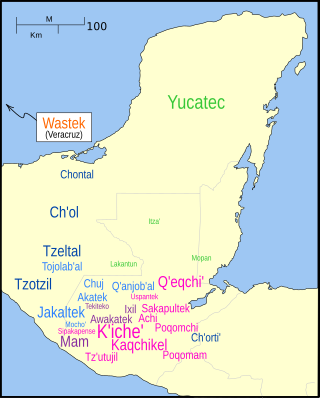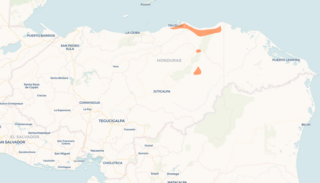Related Research Articles

Crow is a Missouri Valley Siouan language spoken primarily by the Crow Nation in present-day southeastern Montana. The word Apsáalooke translates to "Children of the Large Beaked Bird", which was later incorrectly translated into English as 'Crow'. It is one of the larger populations of American Indian languages with 4,160 speakers according to the 2015 US Census.

Tzeltal or Tseltal is a Mayan language spoken in the Mexican state of Chiapas, mostly in the municipalities of Ocosingo, Altamirano, Huixtán, Tenejapa, Yajalón, Chanal, Sitalá, Amatenango del Valle, Socoltenango, Las Rosas, Chilón, San Juan Cancuc, San Cristóbal de las Casas and Oxchuc. Tzeltal is one of many Mayan languages spoken near this eastern region of Chiapas, including Tzotzil, Chʼol, and Tojolabʼal, among others. There is also a small Tzeltal diaspora in other parts of Mexico and the United States, primarily as a result of unfavorable economic conditions in Chiapas.
The grammar of Classical Nahuatl is agglutinative, head-marking, and makes extensive use of compounding, noun incorporation and derivation. That is, it can add many different prefixes and suffixes to a root until very long words are formed. Very long verbal forms or nouns created by incorporation, and accumulation of prefixes are common in literary works. New words can thus be easily created.
Paumarí is an Arauan language spoken in Brazil by about 300 older adults out of an ethnic population of 900. It is spoken by the Paumari Indians, who call their language “Pamoari”. The word “Pamoari” has several different meanings in the Paumarí language: ‘man,’ ‘people,’ ‘human being,’ and ‘client.’ These multiple meanings stem from their different relationships with outsiders; presumably it means ‘human being’ when they refer to themselves to someone of ostensibly equal status, and ‘client’ when referring to their people among river traders and Portuguese speakers.
The Yimas language is spoken by the Yimas people, who populate the Sepik River Basin region of Papua New Guinea. It is spoken primarily in Yimas village, Karawari Rural LLG, East Sepik Province. It is a member of the Lower-Sepik language family. All 250-300 speakers of Yimas live in two villages along the lower reaches of the Arafundi River, which stems from a tributary of the Sepik River known as the Karawari River.
Ixcatec is a language spoken by the people of the Mexican village of Santa María Ixcatlan, in the northern part of the state of Oaxaca. The Ixcatec language belongs to the Popolocan branch of the Oto-manguean language family. It is believed to have been the second language to branch off from the others within the Popolocan subgroup, though there is a small debate over the relation it has to them.
The Pingelapese language is a Micronesian language native to Pingelap, an atoll belonging to the state of Pohnpei in the Federated States of Micronesia. This atoll is the homeland to the Pingelapese people, consisting of a three-square mile range of uninhabited small coral islets, Daekae and Sukora, and the inhabited islet, Pingelap. These islands partially make up the Caroline Islands.
Classical Kʼicheʼ was an ancestral form of today's Kʼicheʼ language, which was spoken in the highland regions of Guatemala around the time of the 16th-century Spanish conquest of Guatemala. Classical Kʼicheʼ has been preserved in a number of historical Mesoamerican documents, lineage histories, missionary texts, and dictionaries. Most famously, it is the language in which the renowned highland Maya mythological and historical narrative Popol Vuh is written. Another historical text of partly similar content is the Título de Totonicapán.
The Wuvulu-Aua language is an Austronesian language which is spoken on the Wuvulu and Aua Islands and in the Manus Province of Papua New Guinea.
Baiso or Bayso is an Afro-Asiatic, more specifically a Lowland East Cushitic language belonging to the Omo-Tana subgroup, and is spoken in Ethiopia, in the region around Lake Abaya.

Pech or Pesh is a Chibchan language spoken in Honduras. It was formerly known as Paya, and continues to be referred to in this manner by several sources, though there are negative connotations associated with this term. It has also been referred to as Seco. There are 300 speakers according to Yasugi (2007). It is spoken near the north-central coast of Honduras, in the Dulce Nombre de Culmí municipality of Olancho Department.
Warndarrang (waɳʈaraŋ), also spelt Warndarang, Wanderang, Wandaran, and other variants is an extinct Aboriginal Australian language in the Arnhem family, formerly spoken by the Warndarrang people in southern Arnhem Land, along the Gulf of Carpentaria. The last speaker was Isaac Joshua, who died in 1974, while working with the linguist Jeffrey Heath.
Maia is a Papuan language spoken in the Madang Province of Papua New Guinea, and is a member of the Trans-New Guinea language family. It has a language endangerment status of 6a, which means that it is a vigorous and sustainable language spoken by all generations. According to a 2000 census, there are approximately 4,500 living speakers of the language, who are split between twenty-two villages in the Almani district of the Bogia sub-district.
Bukiyip (Bukiyúp), or Mountain Arapesh, is an Arapesh language (Torricelli) spoken by around 16,000 people between Yangoru and Maprik in the East Sepik Province of Papua New Guinea. Bukiyip follows the SVO typology. The Arapesh languages are known for their complex noun-phrase agreement system.
Mekéns (Mekem), or Amniapé, is a nearly extinct Tupian language of the state of Rondônia, in the Amazon region of Brazil.
Yawalapiti (Jaulapiti) is an Arawakan language of Brazil. The Agavotaguerra (Agavotoqueng) reportedly spoke the same language. Speakers of the language live in a village along the edge of the river Tuatuari, a tributary of the Kuluene River, located in the southern part of the Xingu Indigenous Park, in the state of Mato Grosso.
Mortlockese, also known as Mortlock or Nomoi, is a language that belongs to the Chuukic group of Micronesian languages in the Federated States of Micronesia spoken primarily in the Mortlock Islands. It is nearly intelligible with Satawalese, with an 18 percent intelligibility and an 82 percent lexical similarity, and Puluwatese, with a 75 percent intelligibility and an 83 percent lexical similarity. The language today has become mutually intelligible with Chuukese, though marked with a distinct Mortlockese accent. Linguistic patterns show that Mortlockese is converging with Chuukese since Mortlockese now has an 80 to 85 percent lexical similarity.

Baluan-Pam is an Oceanic language of Manus Province, Papua New Guinea. It is spoken on Baluan Island and on nearby Pam Island. The number of speakers, according to the latest estimate based on the 2000 Census, is 2,000. Speakers on Baluan Island prefer to refer to their language with its native name Paluai.
Neve’ei, also known as Vinmavis, is an Oceanic language of central Malekula, Vanuatu. There are around 500 primary speakers of Neve’ei and about 750 speakers in total.
Saliba is an Oceanic language spoken on the islets off the southeastern tip of Papua New Guinea. There are approximately 2,500 speakers of Saliba. Significant documentation of the language was undertaken by the Saliba-Logea documentation project, and hundreds of audio-video resources can be found in the project archive.
References
- ↑ Pohnpeian at Ethnologue (18th ed., 2015) (subscription required)
- 1 2 3 4 5 Dalby 2004.
- 1 2 Pohnpeian-English, M.
- ↑ Lewis, M. Paul, ed. (2009). "Pohnpeian". Ethnologue: Languages of the World (16 ed.). Dallas: SIL International online. Retrieved 2012-12-15.
- 1 2 3 4 5 6 7 Rehg & Sohl 1979.
- 1 2 3 4 5 6 7 8 9 10 11 12 13 14 15 16 17 18 19 20 21 22 23 24 25 26 27 28 29 30 31 32 33 34 35 36 37 38 39 40 41 42 43 44 45 46 47 48 49 50 51 52 53 54 55 56 57 58 59 60 Rehg & Sohl 1981.
- 1 2 Pohnpeian-English, K.
- ↑ Pohnpeian-English, I.
- ↑ Pohnpeian-English, PW.
- ↑ Rehg 2004, p. 505.
- ↑ Bender 2003, pp. 4–5.
- ↑ Rentz 2017.
- Rehg, Kenneth L.; Sohl, Damian G. (1979). Ponapean-English Dictionary. PALI language texts: Micronesia. University of Hawaii Press. ISBN 978-0824805623 . Retrieved 2012-01-08.
- Rehg, Kenneth L.; Sohl, Damian G. (1981). Ponapean Reference Grammar. PALI language texts: Micronesia. University of Hawaii Press. ISBN 978-0824807184 . Retrieved 2012-01-08.
- Bender, Byron W. (2003). "Proto-Micronesian Reconstructions: 1". Oceanic Linguistics. 42 (1): 1–100. doi: 10.2307/3623449 . JSTOR 3623449 .
- Rehg, Kenneth L. (2004). "Linguists, Literacy, and the Law of Unintended Consequences". Oceanic Linguistics. 43 (2): 498–518. doi: 10.1353/ol.2005.0011 .
- Dalby, Andrew (2004). Dictionary Of Languages, The Definitive Reference To More Than 400 Languages. Bloomsbury Pub Ltd. ISBN 978-0231115698 . Retrieved 2012-01-09.
- Rentz, Bradley (2017). "Pohnpeian Topological Relations". Linguistics Vanguard. 3. doi:10.1515/lingvan-2016-0092. hdl: 10125/63283 .
- "Pohnpeian-English". www2.hawaii.edu. Retrieved 2023-11-20.